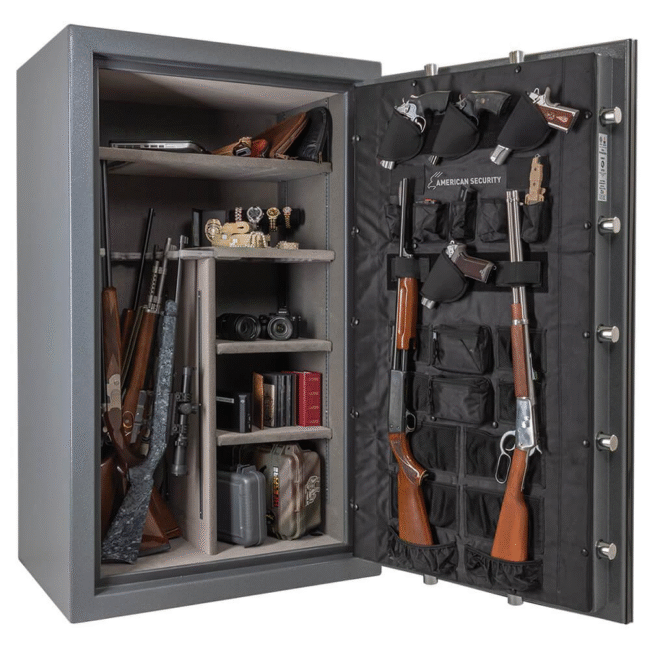When people talk about “fire-rated” gun safes, what they usually mean is time. Thirty minutes. One hour. Two and a half hours. But what does that actually buy you when a house fire is chewing through studs and roof trusses? A fire rating isn’t magic. It’s a system of materials, design, and testing—and if you misunderstand it, you could lose everything you meant to protect.

Why Fire Ratings Matter
A safe that can stop a pry bar but folds in the first ten minutes of a fire isn’t much of a safe. In the U.S., the average house fire reaches 1,100–1,400°F in under 10 minutes. Paper chars at 405°F. Ammo and optics fail even sooner. That’s the gap a fire-rated safe tries to bridge.
The principle is simple: keep the interior below the failure point of its contents long enough for the fire to pass or firefighters to arrive. But the details—construction, insulation type, door seals, test method—make the difference between marketing numbers and real-world protection.
How Fire Ratings Are Tested
Here’s where it usually goes wrong: people assume all “90-minute” ratings are equal. They aren’t.
- UL 72 (Class 350, 1 hr, 2 hr, etc.): This is the gold standard. Safes are placed in furnaces that reach target temperatures, then cooled while internal temps are logged. It’s rigorous and expensive.
- Manufacturer or ETL tests: Many gun safe makers, including Liberty and others, use in-house or contracted furnace tests. These can still be valid, but methods vary—furnace ramp speed, thermocouple placement, and cooling cycles all change results.
- Marketing stretch: A 30-minute safe tested at 1,200°F isn’t the same as one tested at 1,800°F.
Always ask: what curve was used, how fast did the furnace heat, and was a cool-down period included?
Common Fire Rating Tiers
- 30–45 minutes: Entry-level safes. Usually single layers of gypsum board. Good against short kitchen or garage fires, less so in full structural involvement.
- 60–75 minutes: Mid-range protection. Multiple gypsum layers, better door seals. Enough time for fire crews in many suburban areas.
- 90 minutes – 2.5 hours: Heavy hitters. Thicker walls, reinforced doors, ceramic insulation. Built for rural homes or owners protecting paper records, cash, and heirlooms in addition to firearms.
Remember: ratings are lab numbers. Real fires vary with fuel load, construction type, and firefighter response. A 60-minute safe may survive 90 minutes in one fire, or fail in 20 if it’s in a basement full of combustibles.
Materials and Construction
There’s nothing fancy here—just fundamentals.
- Insulation: Most gun safes use Type X fireboard (gypsum with fiberglass). Higher-end models add multiple layers or ceramic composites.
- Seals: Intumescent seals expand when heated, closing gaps around the door. Without them, smoke and heat get in fast.
- Steel skin: The steel doesn’t insulate—it holds structure while the fireboard does the heavy lifting. But thicker steel buys time and integrity.
If the fire rating doesn’t mention seal type or insulation layering, be cautious. A number alone doesn’t tell the whole story.
Practical Considerations
This is where buying decisions usually tilt.
- Placement matters. A safe on a concrete slab against an exterior wall fares better than one on a second floor surrounded by combustible framing.
- Anchoring helps. Anchoring doesn’t just prevent theft—it keeps the safe from tipping in a collapse, which can break seals and expose contents to direct flame.
- Contents matter. Firearms and paper are one thing; digital media, optics, and plastics demand much cooler environments. If you’re storing hard drives or heirloom photos, consider a smaller UL-rated document safe inside the gun safe.
Liberty and Other Manufacturers
Liberty, AMSEC, and Browning all publish fire ratings from 30 minutes to 2.5 hours. Liberty, for example, runs safes through a furnace ramping to 1,200°F in about 10 minutes, then holds at higher temps depending on the model. It’s not UL 72, but it’s a consistent method across product lines, letting you compare Liberty’s own safes fairly.
Buyers often search for the best deal and sometimes try to buy safe online sight unseen. That’s fine—but only if you understand what the rating means and have confidence in the brand’s testing process. Otherwise, you’re gambling with guesswork.
Common Mistakes to Avoid
- Assuming the safe is fireproof. No safe is. Every safe has a limit.
- Chasing the biggest number. A 2.5-hour rating may be overkill in a suburban neighborhood five minutes from a fire station—but worth every penny in a rural cabin.
- Ignoring environment. A 60-minute safe on the second floor surrounded by combustibles may fail faster than a 30-minute safe in a basement corner.
- Underestimating contents. Optics, polymer stocks, and ammo degrade at much lower temps than paper.
Professional Wisdom From the Field
I’ve seen safes that came through fires with paperwork intact, and others that turned into ovens with nothing salvageable. The difference wasn’t the brand name on the door—it was construction, placement, and a rating that matched the threat.
You can’t fool fire any more than you can fool gravity. The old guys knew: better to overshoot your protection than undershoot. Spend the money once, anchor it, and document the rating for insurance. Fast is slow if you have to replace heirlooms later.
Conclusion: Respect Fire, Respect Your Work
Fire ratings aren’t marketing fluff—they’re promises made under test conditions. But the burden’s on you to understand what those numbers mean, how they were earned, and how to match them to your home’s risks.
When you choose a safe, you’re not just buying steel—you’re buying time. Time for firefighters to do their job. Time for your family’s history to survive. Time for your tools, records, and firearms to be passed on rather than lost.
Ask yourself: If my house caught fire tonight, do I trust this box to hold up long enough? If the answer isn’t a solid yes, keep looking.
